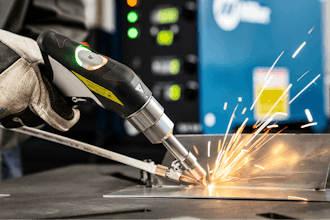
 Capgemini
CapgeminiIn today’s technology driven society, the pace of business is faster than ever. With access to new tools and innovations, manufacturers and distributors are expected to improve efficiency and customer service, delivering more with less and in increasingly rapid ordering cycles. All the while, customer service representatives are spending too much time manually entering emailed orders, instead of using time to grow the business by improving customer relationships.
Faced with this ever-growing demand, it has become vital that distributors and manufacturers optimize their operations, enhancing the efficiency of business processes to remain competitive. To remain competitive, companies know they must provide exemplary customer service and order processing and fulfillment. It can often be difficult to narrow down and identify areas in need of improvement that will generate the necessary high ROI. The important thing to remember is that future success in the distribution industry firmly hinges on the ability to embrace the unique requirements of each customer while processing orders quickly and accurately. This makes identifying areas for improvement a lot easier as the key to achieving this balance is to eliminate error-prone manual order entry, automating the process to accelerate order-to-cash cycles.
Most distributors already have dependable Enterprise Resource Planning (ERP) systems in place to help them automate repetitive administrative tasks, such as inventory control, accounting and shipment. Yet, many still process their customer orders by hand. This procedure entails a huge amount of manual entry from their customer service teams, compiling orders as they arrive and manually processing each one individually before re-entering it into the ERP system as a sales order. In addition to being a slow, labor-intensive task, it is a highly inefficient and expensive use of staff time, prone to continuous, embarrassing errors. Automation of the order-to-cash cycle would render this supplementary work redundant, eliminating manual entry and improving efficiency in a way that generates high ROI. In fact, not only does it reduce operational costs and free staff time to focus on customer service, but it also increases a company’s profitability. With faster order-to-cash cycles, distributors can better manage their cash flow and make capital available to reinvest in their company.
The Difficulty of Eliminating Manual Order Processing
While the benefits of automating order-to-cash cycles are great in theory, in practice the ability to do so has not been readily available until recently.
To implement automation of this process, customer purchase orders have to arrive in an electronic format to be automatically translated into a sales order in the distributor’s ERP system. While there are solutions which offer this opportunity, such as Electronic Data Interchange (EDI), they require considerable time, money and a high level of collaboration between customers and suppliers to execute. Both parties need access to dedicated technical expertise and must devote substantial amounts of time and man-power to implement new software and business processes. Once in place, their benefits are well worth the investment, improving data quality, reducing cost per transaction, eliminating manual order processing, and creating shorter order-to-cash cycles.
Unfortunately, many customers have neither the technical resources nor the desire to help introduce this solution into their business communications. Each customer has their own distinctive internal processes and ways of doing business. Some use fax, others favor email and others choose to place orders through an ecommerce website. With their own systems in place, they are therefore reluctant to duplicate effort, creating purchase orders for their own internal business processes and then entering the same order a second time in a shopping cart or web form for the distributor. Thus, while EDI proves that automating order-to-cash cycles is the right step for high ROI optimization, the reality is that leveraging the investment in this solution is difficult without burdening the customer.
With the drawbacks of EDI, and hundreds of orders arriving daily for processing in different formats, what is needed is a means to bridge the gap between customer convenience and the supplier’s need to optimize and accelerate order-to cash cycles — a sales order automation solution.
Bridging the Automation Gap
Sales order automation solutions can now fill the problematic gap between the distributor’s increasing need for innovation to improve efficiency and each customer’s unique needs and convenience.
However, not all sales order automation solutions are created equal. It is vital that companies assess each solution thoroughly to select the one which best suits their requirements. For example, solutions which use traditional Optical Character Recognition (OCR) technology to estimate data are less accurate than non-OCR based ones. For example, characters such as a straight line may be misinterpreted by OCR technology as the number one, letter I, or the letter L. While small companies may have the capacity and man-power necessary to ensure the process works properly, larger organizations with greater order volumes will probably want to invest in superior, non-OCR technology.
Non-OCR solutions allow companies to treat email, fax and print orders like standard electronic documents, capturing the actual data from them with 100% accuracy and demanding a fraction of the time spent on manual order processing. Once captured, the data then flows into the company’s ERP system and is automatically routed to the appropriate channels with total visibility.
By implementing these solutions, error-prone manual entry is no longer necessary, eliminating its damaging effects on customer care and order-to-cash cycles. Customer service teams can then refocus their energy on other duties rather than dividing their time between providing assistance and entering sales orders into the distributor’s internal system. Even better, these solutions can work in conjunction with an existing EDI investment or on their own, allowing companies to optimize and accelerate their sales order cycles accurately and without the need to inconvenience or change the way their customers do business.
Regardless of whether the customer purchase order arrives in email, online or EDI format, a sales order automation solution can help distributors accelerate order-to-cash cycles. Once introduced, increasing demand can be met in a timely manner without changing the way customers do business. In fact, there is no need to even inform customers of changes to the sales order process so distributors can process and ship orders more quickly and with guaranteed accuracy. Automation can provide companies with that competitive edge to handle higher volumes of orders without adding additional staff and move from customer order to payment more rapidly and efficiently than ever before.
Earl van As is Vice President, Marketing & Product Management at ecmarket, cloud solutions developer of the patent-pending Conexiom sales order and invoice automation solution. Conexiom allows manufacturers and distributors to focus on serving customers and managing supplier relationships instead of entering data. For more information, visit www.conexiom.com.






















